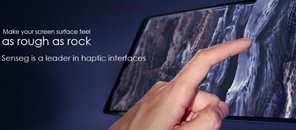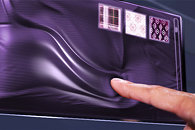- Joined
- Oct 9, 2007
- Messages
- 47,407 (7.52/day)
- Location
- Hyderabad, India
| System Name | RBMK-1000 |
|---|---|
| Processor | AMD Ryzen 7 5700G |
| Motherboard | ASUS ROG Strix B450-E Gaming |
| Cooling | DeepCool Gammax L240 V2 |
| Memory | 2x 8GB G.Skill Sniper X |
| Video Card(s) | Palit GeForce RTX 2080 SUPER GameRock |
| Storage | Western Digital Black NVMe 512GB |
| Display(s) | BenQ 1440p 60 Hz 27-inch |
| Case | Corsair Carbide 100R |
| Audio Device(s) | ASUS SupremeFX S1220A |
| Power Supply | Cooler Master MWE Gold 650W |
| Mouse | ASUS ROG Strix Impact |
| Keyboard | Gamdias Hermes E2 |
| Software | Windows 11 Pro |
Touchscreen display developer Senseg revealed prototypes of its haptic touchscreen displays. Simply put, these are displays that can reproduce the texture and "feel" of surfaces, apart from reproducing moving images. For example, it can reproduce the texture and feel of silk and rock. Senseg is calling its display "Feel Screen". The Feel Screen is already backed by a 4D display technology, in which images consist of "tixels" (pixel with touch-texture information). We've all probably been to 4D movies, in which apart from 3D visuals, a fourth dimension (usually physical effects). Think of compact haptic displays as being similar, only here the fourth dimension is touch texture.
How does it work? Feel Screen, like every touchscreen, could be a layered display at its lowermost layer is the LCD that displays visuals (capable of even stereo 3D), above that is a touchscreen layer, and above that, a haptic layer that generates mild electrostatic fields. Touch-textures are created by making and manipulating an attractive force between the finger and that electrostatic field. The screen can reproduce surface textures and create the sensation of vibrations. Sounds too Sci-Fi? Well, Senseg stated that it will be able to mass produce displays based on this technology in 2012, which will then market by 2013. Senseg owns all patents related to this unique technology. Some of the most valuable ones could be related to how Senseg went about designing its electrostatic haptic layer to prevent it from interfering with the capacitive touchscreen layer. Please don't evaporate.


View at TechPowerUp Main Site
How does it work? Feel Screen, like every touchscreen, could be a layered display at its lowermost layer is the LCD that displays visuals (capable of even stereo 3D), above that is a touchscreen layer, and above that, a haptic layer that generates mild electrostatic fields. Touch-textures are created by making and manipulating an attractive force between the finger and that electrostatic field. The screen can reproduce surface textures and create the sensation of vibrations. Sounds too Sci-Fi? Well, Senseg stated that it will be able to mass produce displays based on this technology in 2012, which will then market by 2013. Senseg owns all patents related to this unique technology. Some of the most valuable ones could be related to how Senseg went about designing its electrostatic haptic layer to prevent it from interfering with the capacitive touchscreen layer. Please don't evaporate.


View at TechPowerUp Main Site
Last edited by a moderator:







 It would sell well with the fun app that simulates broken screen.
It would sell well with the fun app that simulates broken screen.
